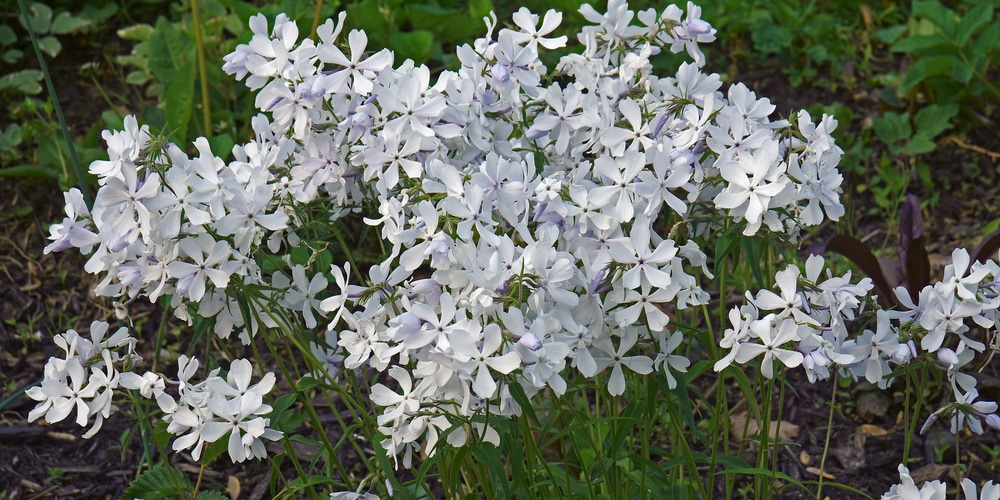If you’ve come across woodland phlox (Phlox divaricata) while out hiking, you may have been enchanted by its beauty. This perennial wildflower is native to dappled woodlands and meadows in eastern North America.
Often used in gardens and landscape designs, this low-growing plant produces delicate, five-petaled flowers in shades of blue, lavender, white, or purple in the early months of spring. It has proved to be a great companion to early bloomers like hellebore and spring-blooming bulbs.
But before you decide to add woodland phlox to your garden, you definitely want to find out more about its spreading habits.
Does Woodland Phlox Spread?
Woodland phlox is definitely a spreader. However, it’s not such an aggressive spreader, so it won’t choke other plants growing around it. On average, each plant will grow to a height of about 6-12 inches tall and wide, depending on the species.
How Quickly Does It Spread?
The woodland phlox, unlike the creeping phlox, is a slow-spreader. As you can expect, however, the spreading rate of such a plant is bound to change depending on various conditions such as the state of the soil, the amount and intensity of shade, and more.
Under the best conditions, woodland phlox will spread fairly fast in, out, and around other plants. As such, you won’t have to worry about having other plants in your garden smothered by your woodland phlox plants.
What Are the Best Conditions for It to Spread?
The first consideration that comes to mind when it comes to growing plants is the hardiness zones where they thrive. Woodland phlox grows best in USDA hardiness zones 3 all the way to 8.
The soil should be preferably humusy, medium moist, and well-drained. These plants can, however, tolerate dry soils as well as clay soils. When fully established, the woodland phlox is astonishingly drought tolerant.
And while this wildflower prefers partial shade, it can still grow without struggling in full sun, as long as it’s grown in a place will a cool climate.
How to propagate woodland phlox
You can use cuttings, shoots, or seeds to propagate woodland phlox.
Using shoots
When using shoots, your best approach would be to carefully dig up around that shoot until you reach it. You can then separate the younger plant at the section where it connects with the mother. Once you’ve done that successfully, use the same soil that the mother plant grows in to transplant the shoots.
Starting from seeds
It will be difficult getting seeds from the mother plant, but the good thing is that you can purchase them. If you purchase seeds, be sure to sow them indoors just before spring starts, to avoid the frost threats from winter. Make sure to use a dark environment for the sowing process, while using humusy, moist soil and providing medium-level moisture.
You can expect the seedlings to appear before spring starts. Once the leaves start to show and you are sure that your seedlings are not at risk of frost, you can transplant them outside.
Rooting from cuttings
You can use either root cuttings taken during early fall or stem cuttings taken in the spring. Of course, these need to be from a healthy section of the woodland phlox plant. Make sure to remove any leaves from the lower section of your cuttings, after which you should dip the cutting in rooting hormone powder.
You can then use rich, moist soil to plant the cuttings in an indoor setting. Make sure that there is enough, indirect sunlight coming in. Having provided these conditions, the cuttings are supposed to establish in a period of one to two months. The best time to transplant either the root or stem cuttings is in the spring.
Growth and reproduction of woodland phlox
If you are interested in growing woodland phlox, it’s important to keep in mind that they will need long-tongued insects for pollination. The most common pollinators of woodland phlox plants include but are not limited to skippers, sphinx moths, swallowtails, bumblebees, and hummingbirds.
Once the plant has flowered and pollination has occurred, you can do some pruning just to tidy up things and refresh the plant’s appearance. You should, however, refrain from cleaning up the clump, and only do so when spring sets in.
Pest and problems of woodland phlox
Generally, woodland phlox plants are rarely bothered by pests or diseases as they grow. The only problem that you will want to keep an eye out for is powdery mildew, which can be addressed quite easily.
All you have to do is to ensure that there is enough circulation in the areas where your plants are growing. In addition, you may need to cut back the stems after blooming to reduce powdery mildew.
You also have to be on the lookout for spider mites if you are growing your phloxes in a hot and dry climate. Rabbits and deer are also known to browse foliage from these plants, so you may need to take some steps to protect your plants if you live in an area where such animals are common.
Related Article: Can Creeping Phlox Grow in Shade?


